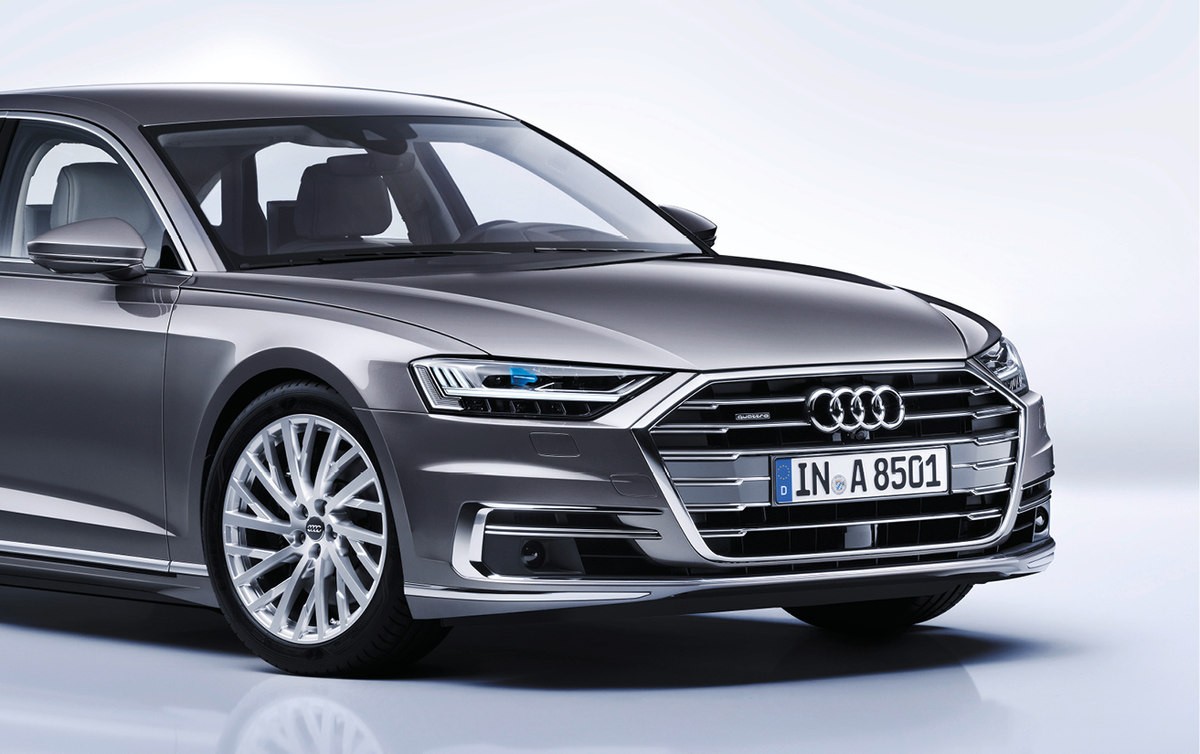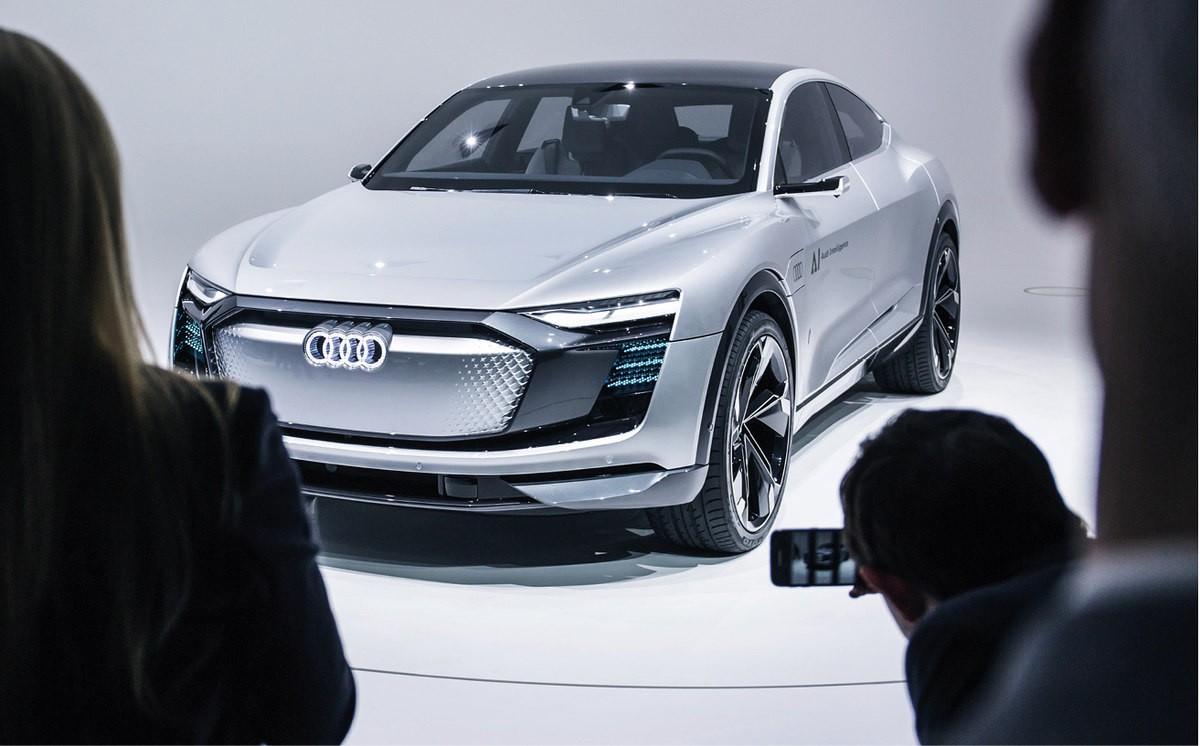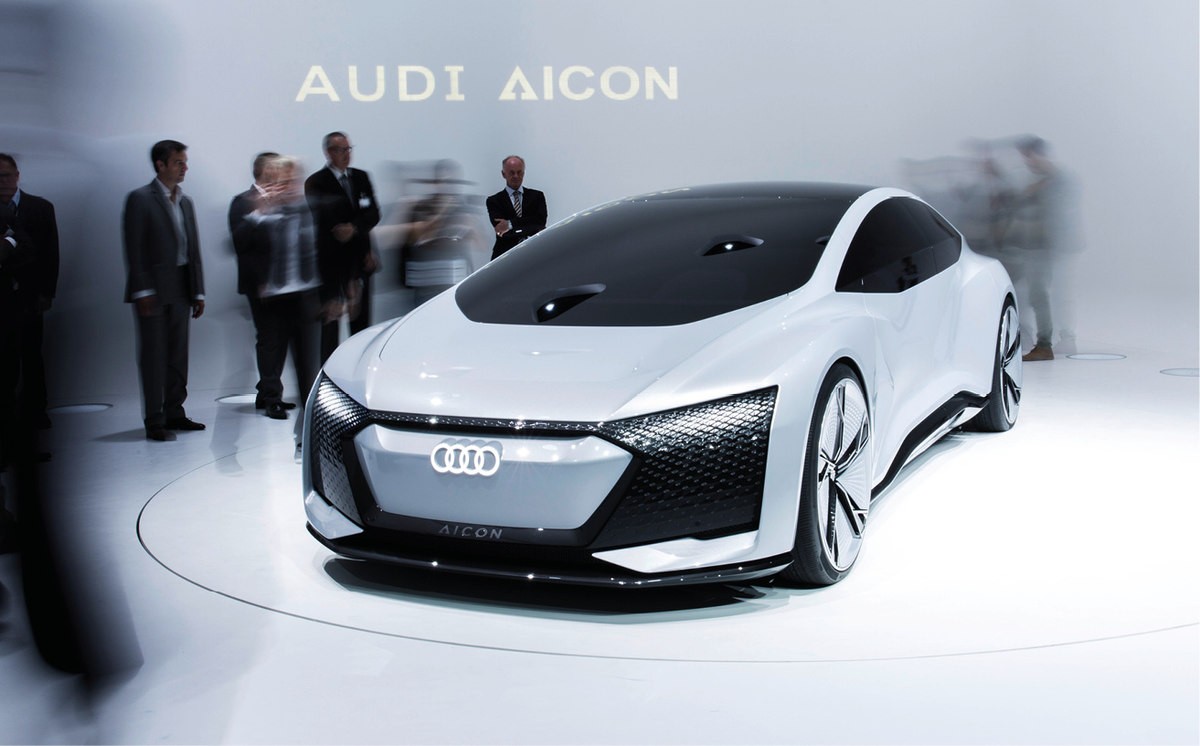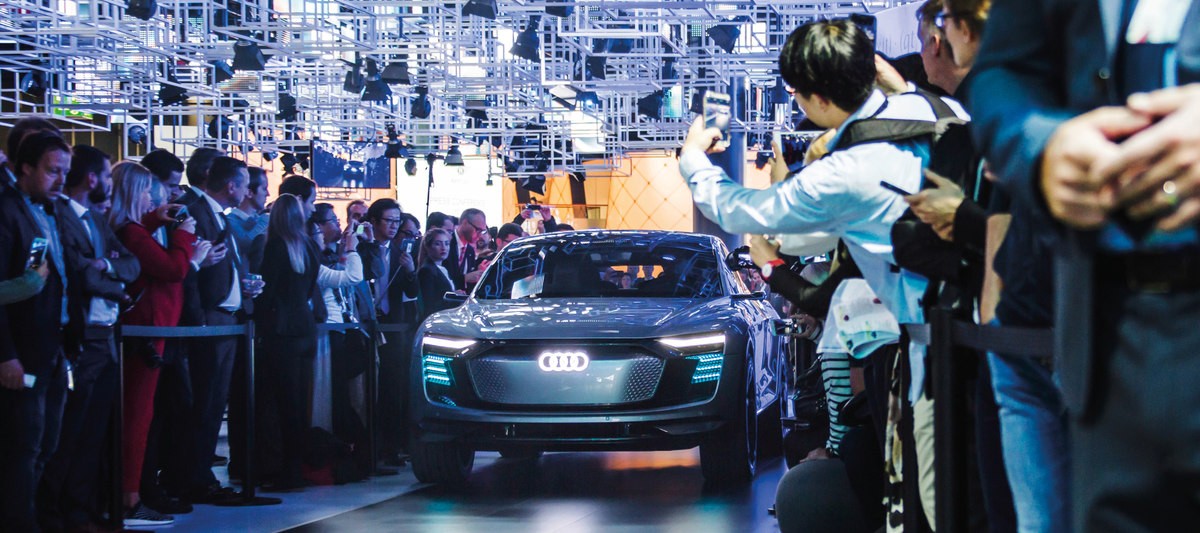
Three tiers of progress
The Frankfurt International Motor Show (IAA) is an excellent opportunity to take a look ahead to tomorrow’s mobility. In its current transitional phase, the automotive industry promises change on a whole new level. The new Audi A8, the Audi Elaine and Audi Aicon among others prove this beyond doubt.
Birte Mußmann (copy) & AUDI AG (photo & video)
The doors to the 67th staging of the Frankfurt International Motor Show (IAA) have closed once again. Between September 14 and 24, some 810,000 visitors flocked to the exhibition grounds. Even now that the event is over, one impression remains: Tomorrow’s mobility is advancing apace. Three Audi cars newly unveiled this year reveal what that future might look like. One of them is a production vehicle, the other two are concept cars. Connectivity, user experience, drive systems and design share the spotlight together with what is inevitably the major topic—piloted driving. To help us understand how far a vehicle has progressed toward that innovative technology, U.S.-based standards developing organization, the Society of Automotive Engineers (SAE), has created a scale starting at Level 1 and extending up to Level 5.
Level 3—the new Audi A8
The new Audi A8, for instance, is the first production car from the four rings stable capable of conditional automated driving in traffic on public roads. In other words, it’s a level 3 car on the SAE scale. For the first time, the car can, within system limits, take over steering in clearly defined traffic conditions where the driver can avert his attention from the job of driving.
Level 3 allows for conditional automated driving. Drivers no longer need to constantly monitor the vehicle’s longitudinal and lateral motion and can, in defined situations, instead engage in other activities offered on board. The system independently determines when it has reached its limits—that is, the point at which traffic conditions no longer correspond to its scope of function. In such cases, the car warns the driver several seconds in advance to resume control of the steering wheel.
Although the Audi AI traffic jam pilot* in the new Audi A8 meets these criteria, drivers must still remain alert. On freeways and multi-lane highways with a physical barrier separating the two directions of travel, the Audi AI traffic jam pilot handles driving in slow-moving traffic at speeds of up to 60 kilometers per hour. To activate the system, the driver presses the AI button on the center console. When operational, the traffic jam pilot handles starting from stationary, accelerating, steering and braking in its lane. Drivers no longer have to continuously monitor the car. Under certain defined traffic conditions, they can take their hands off the steering wheel for longer periods. As soon as the system reaches its limits, it calls on the driver to resume control again.
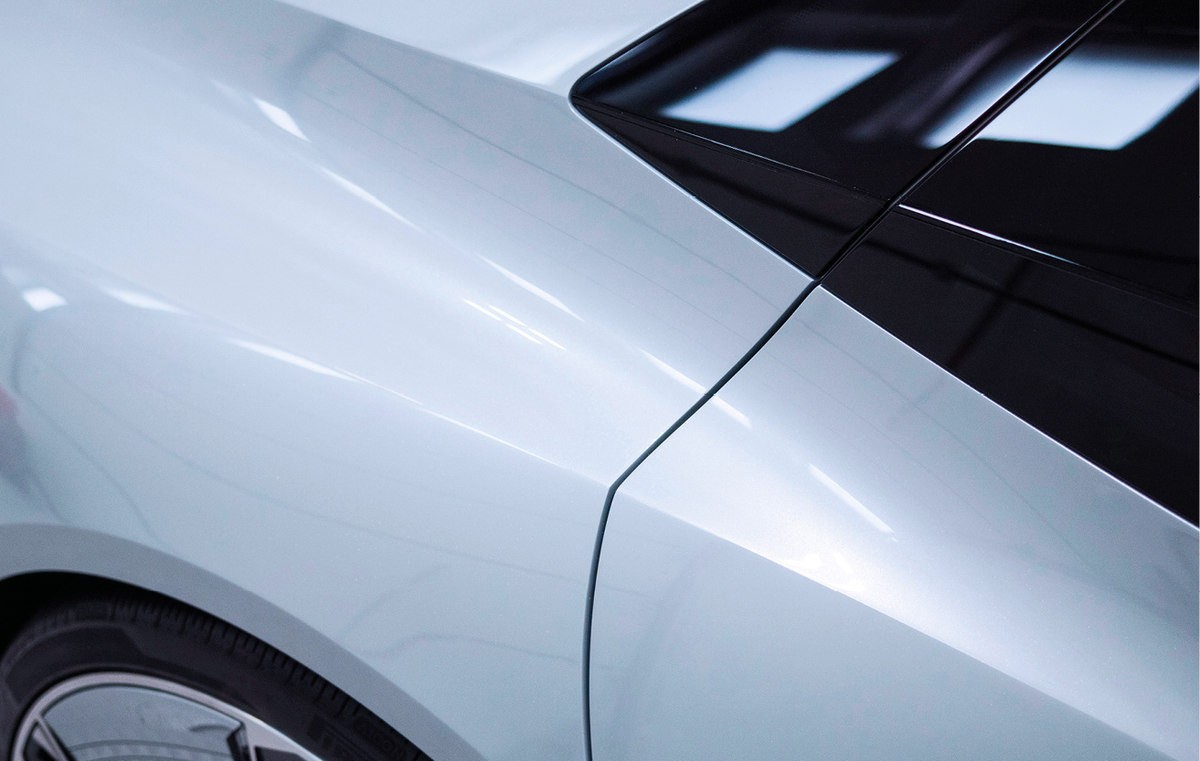

Level 4—Audi Elaine concept car
The Audi Elaine concept car already represents the next level and offers a glimpse of what Audi mobility could look like in future. Equipped with a new-generation processor, the central driver assistance controller (zFAS) at the heart of Audi piloted driving systems boasts more computing power and refined sensors with even greater range and precision. This lets drivers of the concept car use a highway pilot, which makes life easier over longer distances. An extension of the traffic jam pilot in the Audi A8, the highway pilot allows piloted driving also at speeds of between 60 and 130 kilometers per hour. Changing lanes automatically—for instance, overtaking and then returning to the original lane—are all part of the Audi Elaine’s repertoire. It can initiate, perform and complete such maneuvers autonomously, without any involvement on the part of the person behind the wheel. However, if the driver wants to intervene, he can do so spontaneously at any time.
Thanks to integrated Audi intelligence technology and the car’s ability to network with infrastructure, the Audi Elaine is even able to perform tasks without a driver on board. When parked in a designated area known as the Audi AI Zone, the unoccupied car drives automatically into a multistory parking garage offering a variety of services such as a car wash, a package station, a gas station or a charging point. What may sound like the dream of a distant future is, in fact, a project that is racing toward production readiness in leaps and bounds.
Level 4 represents high automation and is exemplified by systems that take a variety of forms. At this level, the car’s capacity to function without the driver’s input is limited to specific operating areas such as highways or parking garages. Here, full driving control can be handed over to the system and the driver need only resume control when the car leaves the area where fully automated operation is permitted. If the driver does not react, the system goes into safe status mode by, for instance, pulling onto the hard shoulder and coming to a standstill there. Robot taxis in city centers are another example of such a system. They fully assume the job of driving within a limited speed range and on a restricted route.


Level 5—Audi Aicon
With the four-door Audi Aicon design study, the brand with the four rings has unveiled its fully autonomous car of the future—with no steering wheel or pedals. As a design concept, the four-door 2 plus 2 represents another bold leap forward, anticipating the exterior and interior styling of the next decades. The technology showpiece is a visionary blend of innovations relating to the drivetrain, suspension, digitalization and sustainability. It is designed for purely electric operation, with a target range of between 700 and 800 kilometers on a single charge.
At level 5, driving is fully autonomous and the car is responsible for executing longitudinal and latitudinal movements. There are no situations in which systems at this level require human intervention. Consequently, controls such as a steering wheel and pedals are no longer necessary.
Communications and customization also reach new heights in the concept car. Occupants can choose to convey instructions to the vehicle via voice control or eye tracking. Sensors in the front end of the interior analyze where occupants’ gaze falls, allowing functions to be selected with a mere glance. PIA, the Audi personal intelligent assistant, makes sure things are just the way occupants like them. The empathetic electronic vehicle assistant recognizes passengers by their smartphones and activates all of their personal settings. Air conditioning, seating position, interior lighting color and the layout of the infotainment system are adjusted according to each occupant’s preferences. Tomorrow’s mobility is clearly taking shape.
Audi RS 4 Avant fuel consumption combined (in l/100 km): 8,8; CO2 emissions combined (in g/km): 200-199, Audi R8 V10 RWS fuel consumption combined (in l/100 km): 12,6-12,4; CO2 emissions combined (in g/km): 286-283, Audi A8 fuel consumption combined (in l/100 km): 7,8-7,5; CO2 emissions combined (in g/km): 178-171. Where stated in ranges, fuel consumption, CO2 emissions and efficiency classes depend on tires/wheels used.
Further information on official fuel consumption figures and the official specific CO₂ emissions of new passenger cars can be found in the guide “Information on the fuel consumption, CO₂ emissions and electricity consumption of new cars”, which is available free of charge at all sales dealerships and from DAT Deutsche Automobil Treuhand GmbH, Hellmuth-Hirth-Strasse 1, 73760 Ostfildern-Scharnhausen, Germany (www.dat.de).
*The assistance systems/automated technologies described here are still under development and not available in production vehicles. The Audi AI traffic jam pilot is not yet available as an optional extra. Your Audi partner will be pleased to inform you about the exact date of introduction. In most countries, piloted/automated driving is currently not legally approved for use on public roads. Please also note in general that assistance systems can only support the driver within the specified system limits. Responsibility for remaining sufficiently alert and performing driving tasks rests at all times with the driver.
